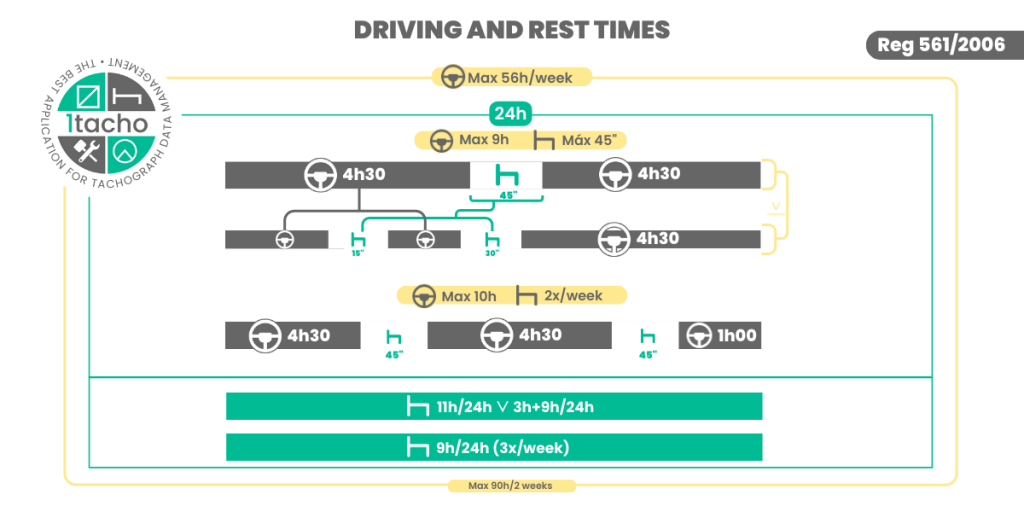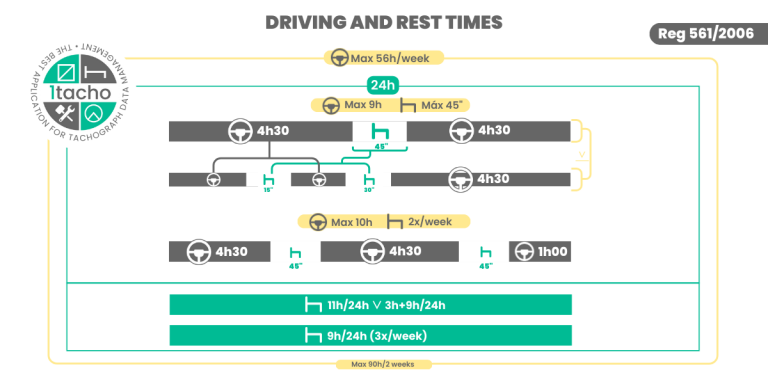As a heavy goods vehicle driver, you understand the critical importance of ensuring proper driving and rest times. In this article, we will delve into how you can ensure compliance with these essential regulations while also gaining an understanding of how the tachograph works. Are you ready to embark on this journey? Let’s get started!
Introduction
Operating a heavy goods vehicle is an immense responsibility. Ensuring road safety is a duty we all share, and it begins with strict compliance with driving and rest times. In this article, we will explore what these times are, why they are crucial, and how the tachograph can be your ally in this mission.
What Are Driving and Rest Times?
Driving and rest times are regulations that dictate how much time a heavy goods vehicle driver can spend on the road and how much time they should rest. In essence, they ensure that you, as a driver, are in good condition to drive and prevent fatigue that can lead to accidents.
Key Points to Understand About Driving and Rest Times:

- Daily Driving Period: A maximum of 9 hours per day.
- Weekly Driving Period: A maximum of 56 hours per week.
- Fortnightly Driving Period: A maximum of 90 hours over 2 weeks.
- Breaks: You must take breaks during driving, including a 45-minute break after 4.5 hours of driving.
- Daily Rest Period: At least 11 hours between shifts, with exceptions.
- Weekly Rest Period: At least 45 consecutive hours, in addition to the daily 11-hour rest period, with exceptions.
The Significance of Adhering to Driving and Rest Times

Adhering to these regulations is paramount for road safety. Fatigue is one of the leading causes of accidents, and following driving and rest times helps prevent you from becoming a risk to yourself and others.
A Simple Scenario
Imagine you are driving a heavy goods vehicle, feeling tired but needing to continue for a few more hours to meet a deadline. Fatigue sets in, and your concentration wanes. Now, consider the danger this poses. Adhering to driving and rest times is like ensuring that you are always alert and safe.
Tachograph: Your Ally in Time Management
The tachograph is a critical device that records your driving activities. It functions like a guardian, monitoring your driving and rest times. This device records vital information, such as vehicle speed, driving time, and breaks. It is essential for ensuring your compliance with regulations.
Basic Rules for Using a Tachograph:
- Ensure the tachograph is functioning correctly before starting your journey.
- Record all driving and rest activities accurately.
- Do not attempt to manipulate the information recorded by the tachograph, as this is illegal.
Regulations and Laws
Complying with driving and rest times is not just a safe practice; it is a legal obligation. In each country, regulatory authorities establish strict regulations that heavy goods vehicle drivers must adhere to.
Key Regulations:
- Regulation 561/2006: Defines driving and rest times and the mandatory use of the tachograph.
- Regulation 165/2014: Sets guidelines for the use and handling of tachographs.
Calculating Driving and Rest Times

Calculating driving and rest times may seem complex, but it is essential to ensure compliance. Here are the basic steps:
- Record Your Hours: Keep an accurate record of the start and end of each driving and rest period.
- Calculate the Daily Driving Period: Add up the driving time for a day/journey.
- Check Breaks: Ensure you take breaks as needed.
- Calculate the Rest Period: Ensure you have at least 11 hours of daily rest; exceptions allow for 9 hours three times a week.
Tips to Ensure Compliance with Times
Complying with driving and rest times can be challenging, but it is crucial. Here are some tips to help you maintain compliance:
- Planning: Plan your journey in advance, taking driving and rest times into account.
- Regular Breaks: Take short breaks every 4.5 hours of driving to rest and refresh.
- Avoid Rush: Do not feel pressured to exceed time limits to meet deadlines; your safety comes first.
- Maintenance: Keep your vehicle in good condition to prevent delays due to mechanical problems.
Consequences of Non-Compliance
Failing to comply with driving and rest times can result in severe consequences. This includes fines, loss of driver’s license points, temporary or permanent suspension of driving privileges, and, most importantly, risks to road safety.
Advantages of Complying with Driving and Rest Times

Complying with these regulations may seem challenging, but it offers numerous advantages:
- Safety: The primary benefit is road safety, for both you and others.
- Professional Reputation: Adhering to times demonstrates professionalism and responsibility.
- Avoiding Fines: Compliance with regulations avoids financial penalties.
- Personal Well-being: Ensuring adequate rest time improves your health and well-being.
- Savings: Avoiding infractions and their associated costs.
Clearing Your Doubts: Frequently Asked Questions
Now, let’s address some frequently asked questions that heavy goods vehicle drivers have about driving and rest times and the use of tachographs.
FAQ 1: What Happens If I Exceed the Allowed Driving Time?
Exceeding the allowed driving time violates national and community regulations. This can result in fines, loss of driver’s license points, and risks to your safety and that of others on the road.
FAQ 2: How Can I Prevent Fatigue During Long Hauls?
To prevent fatigue, take regular breaks, stay hydrated, and rest adequately before starting your journey. Prioritize your health and well-being.
FAQ 3: Is There Any Flexibility in Driving and Rest Times?
Regulations are strict, but there are exceptions in emergency situations. Always document exceptional circumstances properly.
FAQ 4: What to Do in Case of Inspection by Authorities?
Cooperate with the authorities during inspections. Honestly and transparently present your driving and rest records, as well as tachograph data.
FAQ 5: What Are the Key Differences Between Driving and Rest Times for Heavy Goods and Light Vehicle Drivers?
Driving and rest times for heavy goods vehicle drivers are generally
stricter than those for light vehicle drivers due to the more demanding nature of heavy goods vehicle driving.
Conclusion
Compliance with driving and rest times is essential for road safety and your own well-being. Use the tachograph as your ally in this mission and strictly follow the regulations. Remember, your safety and the safety of everyone on the road depend on it. Drive responsibly and respect the time limits. Now that you have all the necessary information, don’t let doubts hinder your compliance. Adhere to driving and rest times and make the roads a safer place for everyone.


